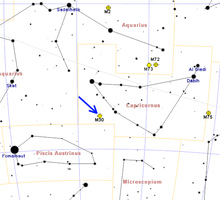M30 (球状星团)
M30(也称为NGC 7099)是位于南天摩羯座的一个球状星团。它是法国天文学家梅西耶在1764年发现的,但他将它描述为一个没有恒星的圆形星云。在1880年代编辑的NGC天体表则将它描述为"显著的球形,明亮、巨大,略呈椭圆"。这个星团使用10×50的双筒望远镜就很容易看见[9],像是一个朦胧的光斑,直径大约4角秒宽,沿东西方向的轴稍长些[9]。使用口径更大的天文望远镜,可以解析出单颗的恒星,星团的范围扩大到12角秒,致密的核心大约是1角秒[10]。最适合观赏的时间是每年的8月[9]。
| 梅西耶30 | |
|---|---|
 | |
| 观测数据(J2000 历元) | |
| 分类 | V[1] |
| 星座 | 摩羯座 |
| 赤经 | 21h 40m 22.12s[2] |
| 赤纬 | –23° 10′ 47.5″[2] |
| 距离 | 27.14 ± 0.65 kly(8.3 ± 0.20 kpc)[3][4] |
| 视星等 (V) | +7.7[5] |
| 视直径(V) | 12'.0 |
| 物理性质 | |
| Mass | 1.6×105[6] M☉ |
| 金属量 | –2.27[7] dex |
| 估计年龄 | 129.3 亿年[8] |
| 其它名称 | M30、NGC 7099、GCl 122[5] |
M30与地球的距离大约是27,100光年[4],直径大约93光年[10]。估计它的年龄是129.3亿年[8],质量约是太阳的160,000倍[6]。这个星团的轨道穿过内银晕,并且是逆行的,这表明它是来自卫星星系,而不是在银河系内形成[8]。它目前与银河中心的距离大约是22.2 kly(6.8 kpc),与太阳的距离估计是26 kly(8.0 kpc)[11]。
M30这个集团已经经历过核心崩溃的动态过程,现在集中在核心的质量大约是每立方秒差距100万太阳质量;这使它成为银河系中密度最高的区域之一。如此接近的恒星距离,使得这些恒星不仅有很高的比例是联星系,而且彼此间会因为质量的转换而形成蓝掉队星[3]。大规模的分异过程可能导致中心区域获得大比例的大质量恒星,从而产生颜色梯度,使星团中心的蓝色调增强[12]。

相关条目
编辑外部链接
编辑- Globular Cluster M30 @ SEDS Messier pages (页面存档备份,存于互联网档案馆)
- Messier 30, Galactic Globular Clusters Database page (页面存档备份,存于互联网档案馆)
- Gray, Meghan. M30 – Globular Cluster. Deep Sky Videos. Brady Haran. [2018-10-17]. (原始内容存档于2020-07-02).
- WikiSky上关于M30 (球状星团)的内容:DSS2, SDSS, GALEX, IRAS, 氢α, X射线, 天文照片, 天图, 文章和图片
参考资料
编辑- ^ Shapley, Harlow; Sawyer, Helen B., A Classification of Globular Clusters, Harvard College Observatory Bulletin, August 1927, 849 (849): 11–14, Bibcode:1927BHarO.849...11S.
- ^ 2.0 2.1 Goldsbury, Ryan; et al, The ACS Survey of Galactic Globular Clusters. X. New Determinations of Centers for 65 Clusters, The Astronomical Journal, December 2010, 140 (6): 1830–1837, Bibcode:2010AJ....140.1830G, arXiv:1008.2755 , doi:10.1088/0004-6256/140/6/1830.
- ^ 3.0 3.1 Lugger, Phyllis M.; et al, Chandra X-Ray Sources in the Collapsed-Core Globular Cluster M30 (NGC 7099), The Astrophysical Journal, March 2007, 657 (1): 286–301, Bibcode:2007ApJ...657..286L, arXiv:astro-ph/0606382 , doi:10.1086/507572
- ^ 4.0 4.1 Kains, N.; et al, Estimating the parameters of globular cluster M 30 (NGC 7099) from time-series photometry, Astronomy and Astrophysics, July 2013, 555 (1): 36–50, Bibcode:2013A&A...555A..36K, arXiv:1305.3606 , doi:10.1051/0004-6361/201321819
- ^ 5.0 5.1 M 30. SIMBAD. 斯特拉斯堡天文资料中心. [2006-11-16].
- ^ 6.0 6.1 Vande Putte, D.; Cropper, Mark, Detecting the effect of globular cluster impacts on the disc of the Milky Way, Monthly Notices of the Royal Astronomical Society, January 2009, 392 (1): 113–124, Bibcode:2009MNRAS.392..113V, arXiv:0811.3106 , doi:10.1111/j.1365-2966.2008.14072.x
- ^ Boyles, J.; et al, Young Radio Pulsars in Galactic Globular Clusters, The Astrophysical Journal, November 2011, 742 (1): 51, Bibcode:2011ApJ...742...51B, arXiv:1108.4402 , doi:10.1088/0004-637X/742/1/51.
- ^ 8.0 8.1 8.2 Forbes, Duncan A.; Bridges, Terry, Accreted versus in situ Milky Way globular clusters, Monthly Notices of the Royal Astronomical Society, May 2010, 404 (3): 1203–1214, Bibcode:2010MNRAS.404.1203F, arXiv:1001.4289 , doi:10.1111/j.1365-2966.2010.16373.x
- ^ 9.0 9.1 9.2 Bone, N. M., Sky notes, 2008 August & September, Journal of the British Astronomical Association, August 2008, 118 (4): 231–232, Bibcode:2008JBAA..118..231B
- ^ 10.0 10.1 O'Meara, Stephen James, The Messier objects, Deep-sky companions, Cambridge University Press: 108, 1998, ISBN 0-521-55332-6
- ^ Dinescu, Dana I.; et al, Space Velocities of Southern Globular Clusters. II. New Results for 10 Clusters, The Astronomical Journal, January 1999, 117 (1): 277–285, Bibcode:1999AJ....117..277D, doi:10.1086/300699
- ^ Howell, Justin H.; Guhathakurta, Puragra; Tan, Amy, Radial Color Gradient and Main-Sequence Mass Segregation in M30 (NGC 7099), The Astronomical Journal, March 2000, 119 (3): 1259–1267, Bibcode:2000AJ....119.1259H, arXiv:astro-ph/9912002 , doi:10.1086/301270